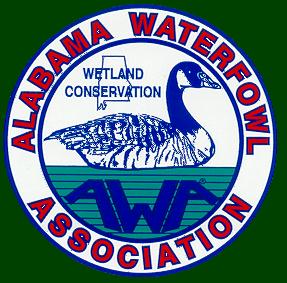Alabama Waterfowl Association">
-
- Alabama Waterfowl Association, Inc.
- 1346 COUNTY ROAD #11
- SCOTTSBORO, ALABAMA 35768
-
- State Member of the North American Waterfowl Federation (NAWF)
CONSERVATION ALABAMA
Mallard Stewardship Project
I would like to take this opportunity to give a
few tips on how to develop your habitat into the optimum opportunity and make it the most
cost efficient way to raise a wild mallard; "You know only mother nature can do it
better".
Okay, you just received ducks from AWA; they are banded and ready for
your habitat at 35 days old. Here is how you can save money and use the AWA Conservation
Seed Program to assist you. Ducks obtained from AWA are placed in a pen and have a pond to
enjoy. The new wrinkle in the nationwide program for rearing ducks is a concept that AWA
is promoting.
Usually with 500 or more ducks, feeding the ducks the extra weeks
costs more money for participants. Here is how all of you can save money by using the AWA
seed program and planting your own food if resources are available. If resources are not
available, maybe someone will contract and provide the food for your ducks.
Top Secret Idea
The cheapest way to raise and store food for the ducks in a Mallard Stewardship Program
is to plant or broadcast, sorghum, soybean and millet, wheat, and sudan and bail into
round bails of what is called hay. You can store these bails for years if you use the new
covers or place under a shed. You can place these round bails into the pens that contain
the ducks. The ducks can have a smorgasbord of food by placing a variety of the round
bails into the containment area. You can take a truck or tractor and bump the round bails
to unroll the available food source. This provides and conditions the ducks with the best
of food sources and habitats that will be available in the winter in Alabama in the wild.
Supplement this grain with protein unless you are fortunate enough to have natural protein
supplements in the form of invertebrate and grasshoppers.
The hay bail concept is brand new and is the innovative idea of the Alabama Waterfowl
Association. Please exercise caution when using this concept. Also, when unrolling the
bails, inspect for evidence of molded, contaminated hay (where water has seeped into the
bail). If need be, cut, condition, re-roll, and cover small hay bails with newer fabrics.
(Check out the pictures that document this procedure.)
Remember increase harvest and bird watching opportunities and the private sector will
respond and create more habitats.
Jerry D. Davis, CEO
For seeds check the AWA Seed
Program







